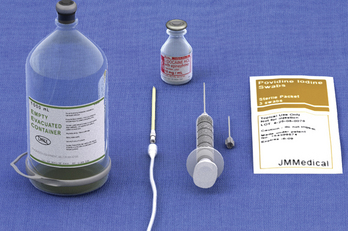Chapter 38 Paracentesis
Equipment
Paracentesis kits are available, although for large volume paracentesis, a simple IV catheter with connection tubing and vacuum bottles works well for safe drainage of abdominal fluid. A 3¼-in., 16-gauge IV catheter is ideal for drainage of large volumes (Figure 38-1).
Key steps
1. Preparation: The insertion site should be selected on or near the midclavicular line in the lower quadrant at the level of the anterior inferior iliac crest (Figure 38-2). In patients with a large amount of fluid and an empty bladder, a midline entry point approximately 5 to 7 cm below the umbilicus is another approach that is acceptable. Using a portable ultrasound to check the planned entry site is ideal if available, but not required in most cases. In patients with malignant effusions with possible adhesion, ultrasound guidance is preferred. Place the patient in a supine position, and cleanse site with antiseptic solution. The area should be covered with a sterile protective drape.
Stay updated, free articles. Join our Telegram channel

Full access? Get Clinical Tree



